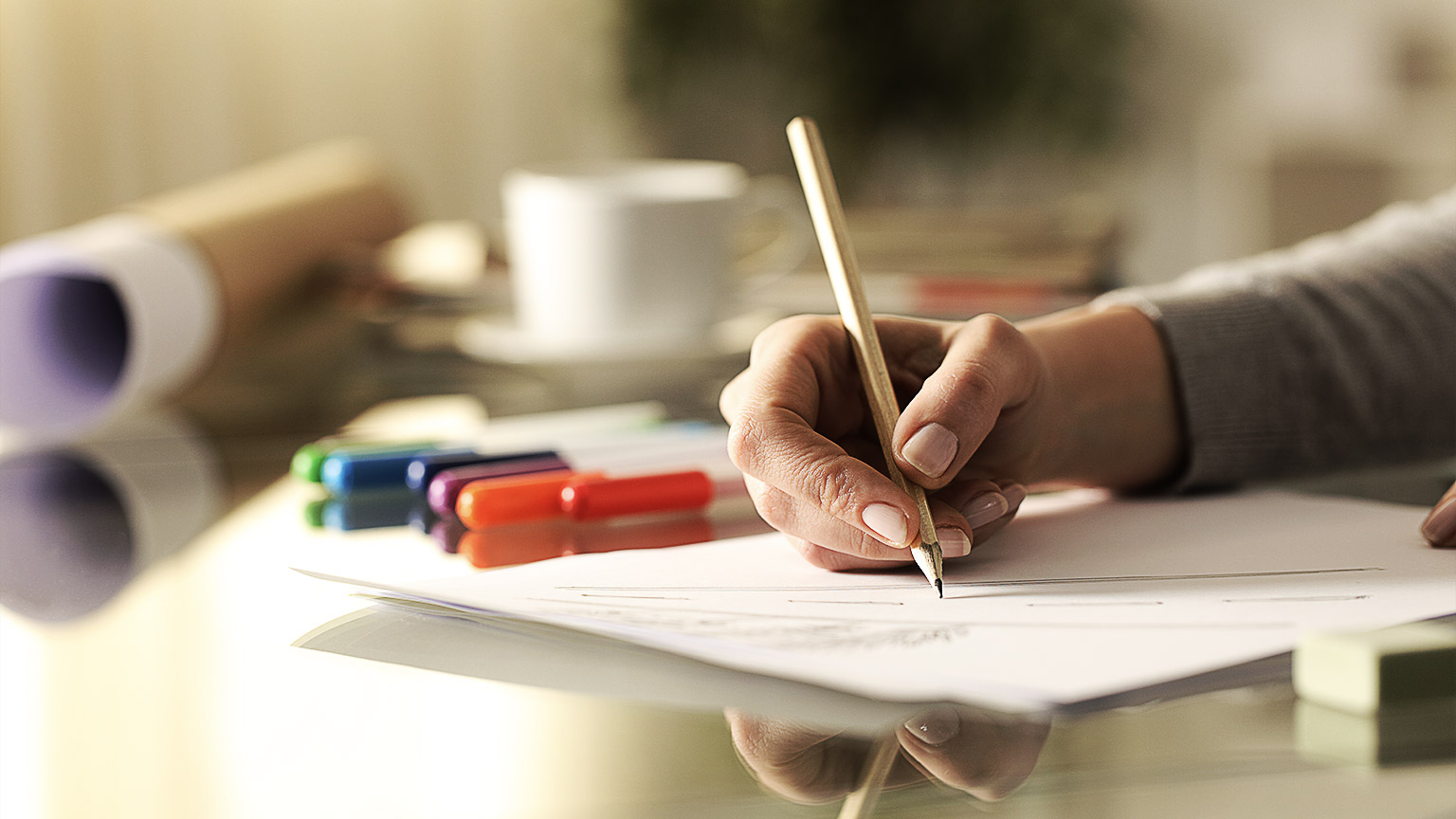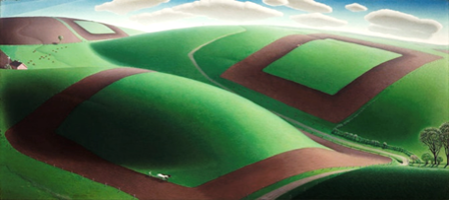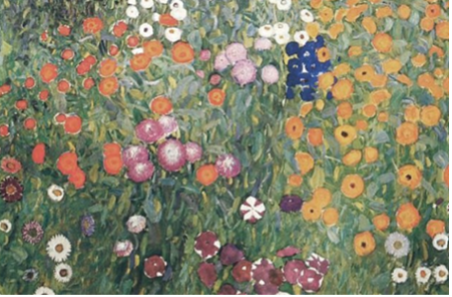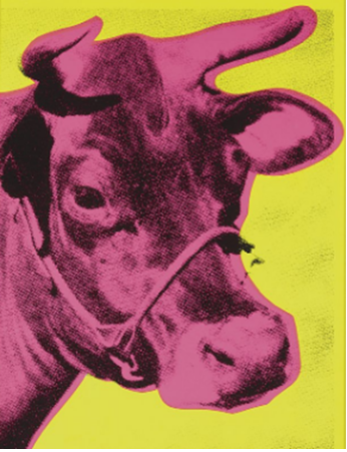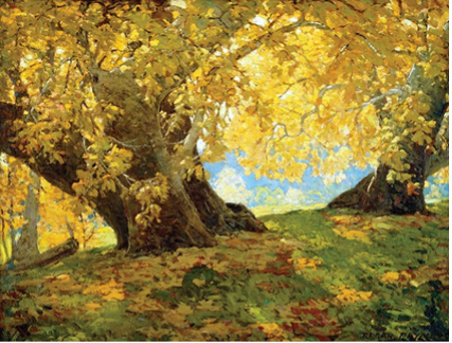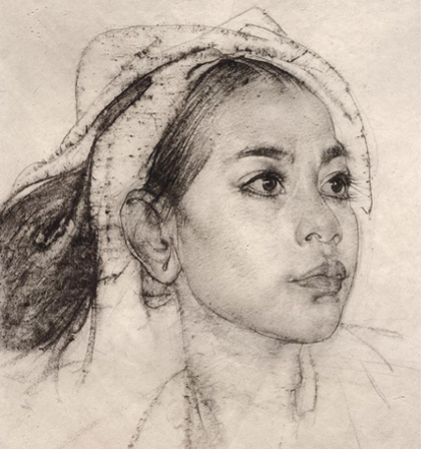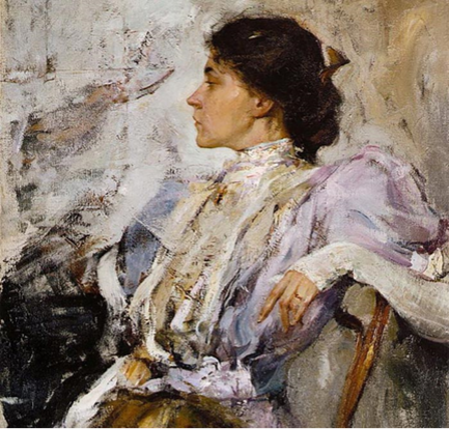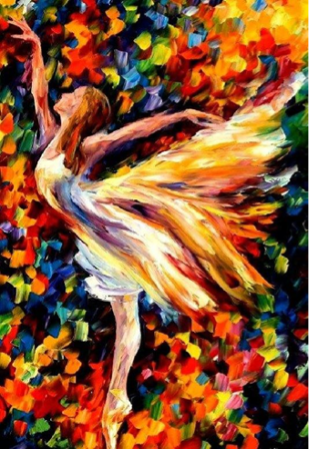Welcome to topic 3 – Support and develop practice through experimentation with drawing and visual representation. This topic will allow you to experiment with techniques, tools and materials to generate new or innovative skills. You will learn about the benefits of hand-drawing and how to create texture, variety and colour. You will learn to consider presentation situations within your work, and how to work safely.
You will be introduced to the following topics:
- Establish and follow safe work practices for selected techniques
- Generate and develop ideas using different materials and techniques
- Consider the presentation situation when selecting techniques, tools and materials
- Create variety in compositions and spatial fields using visual elements
- Experiment with techniques and mixed media to produce single and multi-colour visuals
- Compare and contrast the value of electronic and hand drawing for specific purposes
Overview of work health and safety (WHS)
Work health and safety (WHS) – sometimes called occupational health and safety (OHS) – refers to the tasks we undertake to protect the health and safety of all people present in a workplace. All people have the right to a healthy and safe environment, including at work. State/territory legislation and regulations outline the WHS responsibilities of employers/supervisors/employees:3
| ACT | Work Health and Safety Act 2011 (ACT) | Work Health and Safety Regulation 2011 (ACT) |
| NSW | Work Health and Safety Act 2011 (NSW) | Work Health and Safety Regulation 2017 (NSW) |
| NT | Work Health and Safety (National Uniform Legislation) Act 2011 (NT) | Work Health and Safety (National Uniform Legislation) Regulations (NT) |
| QLD | Work Health and Safety Act 2011 (QLD) | Work Health and Safety Regulation 2011 (QLD) |
| SA | Work Health and Safety Act 2012 (SA) | Work Health and Safety Regulation 2012 (SA) |
| TAS | Work Health and Safety Act 2012 (TAS) | Work Health and Safety Regulation 2012 (TAS) |
| VIC | Occupational Health and Safety Act 2004 (VIC) | Occupational Health and Safety Regulations 2017 (VIC) |
| WA | Occupational Safety and Health Act 1984 (WA) | Occupational Safety and Health Regulations 1996 (WA) |
It is important to emphasise that all people in a workplace – including employers, supervisors and employees – have WHS roles and responsibilities. All people must:
- Take reasonable care of their own health and safety
- Follow reasonable health and safety instructions from a responsible person
- Ask if they are unsure how to safely perform a work-related task
- Use personal protective equipment (PPE) as they were trained and instructed to
- Report injuries and unsafe and unhealthy situations4
A ‘duty holder’ – specifically, an employer or a supervisor – also has additional roles and responsibilities associated with WHS. For example: duty-holders must also:
- Provide a working environment which is reasonably healthy and safe
- Acquire and maintain up-to-date knowledge of WHS matters
- Ensure they thoroughly understand the nature of the operations of the organisation, and the WHS hazards and risks associated with those operations
- Ensure appropriate resources are used to identify hazards and manage risks
- Ensure processes are in place to collect and respond to WHS information/data
- Consult with employees on WHS issues, including risk management strategies
- Provide employees with training on WHS matters, where this is required
- Ensure the organisation complies with reporting and investigating WHS issues5
Explain the work health and safety considerations for drawing
At all times in role – including when using drawing and other visual representation tools – you must comply with WHS requirements. These help you to fulfil your legal and ethical responsibility to keep yourself and others safe in the workplace. Consider these examples of WHS issues associated with the tools and materials used for design, and strategies you can implement to manage them:
| Strain on muscles | Prolonged sitting at a desk can result in strain on your muscles, particularly in your back/neck/arms. To minimise this risk, adjust your workstation so that:
|
| Strain on eyes | Staring at a page can result in significant strain on your eyes. You should ensure your work is appropriately lit by a bright white light. Look away from the work frequently, and take regular breaks to rest your eyes. If you wear glasses, ensure these have a current, correct prescription. |
| Use of sharp materials | Take care when using and moving sharp materials, such as sharpened graphite pencils. For example: never carry sharpened pencils with their tips exposed. If you or another person sustains an injury from a sharp material, wash the area thoroughly and seek medical advice. |
| Exposure to toxic materials | Most of the materials you use when creating freehand sketches will be non-toxic. However, it is important to acknowledge that some inks can have toxic effects if a person is exposed to them in high concentrations, or if they ingest them. Inks should be kept out of reach of children/pets. Exposure to potentially toxic materials should be minimised. If exposure occurs, seek advice. |
Consider the following images, which illustrate correct workstation setup:
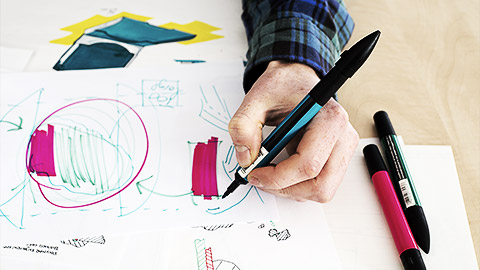
When creating your own work, you should use a range of different materials and techniques. The following is a list of materials and techniques you can use.
Describe the physical properties and capabilities of a wide range of materials used in drawing and visual representation
| Material | Physical Properties | Capabilities |
|---|---|---|
|
A soft, porous material, made of natural colours (ochre, red, black, etc.) or synthetic colours (e.g. pale pink, yellow, blue, green, purple, etc.). Natural chalk is composed of calcium carbonate, though synthetic chalks are often a mix of materials. | Easily smudged and blended, and creates a ‘dusty’ effect; often, pale colours are used. |
|
A black, crumbly material. Made of finely-ground organic substances, including natural charcoal (burned wood), held by a gum or wax binder, and shaped into a block or a stick. | Black in colour; used for sketching and shading. |
|
A crayon – also referred to as a wax pastel – is a stick of coloured wax, usually covered in paper for ease of use. There are a huge variety of different colours, sizes and textures available, to suit the artist’s needs. | Used to create ‘heavier’ drawings; solvents can be used to soften / blend; colours built by layering. |
|
Ink is a coloured fluid or paste. It is often applied to heavy paper, or other materials such as silk. It is often diluted and used similarly to water colour paints (see following), with tones / shades achieved by varying the density of the ink. | Often used to create single-colour, heavily toned / shaded paintings; may also be used in calligraphy. |
|
Paint is a fluid, usually pigmented material which, when spread in a thin layer over a surface, will form a solid, adherent, cohesive film. | Use to develop creative works where ideas are communicated through brushwork or similar techniques. |
|
These may be ‘hard’ (powdered pigment plus a binder, with a similar composition to chalk) or ‘soft’ (with a similar composition to crayons). Soft pastels are rich and luminous in colour, provide a loose grainy texture and are easy to blend with varied surface effect, but are a little fragile. Hard pastels are a little less vibrant in colour, but more stable than soft pastels. They're great for adding detail to your drawings. Oil pastels can also be used. Good choices of paper for pastel drawing have a neutral pH, such as canvas, watercolour paper, pastel paper and sand board.7 | As with chalk and crayons, used to create smudged, blended drawings. |
|
A narrow core of solid pigment, surrounded by a protective casing (usually of wood). Pencils may be ‘lead’ pencils, usually comprised of graphite, or coloured pencils, comprised of a pigment with a binder. Pencils are usually sharpened. Pencils are graded according to the ‘HB’ system, where ‘H’ means hard and ‘B’ means soft. 9H is the lightest and hardest of the graphite pencils, and 7B is the softest and darkest. Pencils must be sharpened prior to use, and regularly as they are used to ensure the tip is pointed. |
Used for a variety of purposes, from sketching to shading and applying block colour. |
|
An instrument used to apply ink to a surface. Some pens require a nib to be dipped in ink; the nib draws up ink, and deposits the ink when it is applied to a surface. Most modern pens involve a ballpoint, fountain or felt/ceramic tip to apply ink contained within the body of the pen in a smooth, consistent way. There are a variety of colours, thicknesses and other effects. | Usually used for sketching outlines; may be used for shading. |
|
Paints or pencils which are designed to be mixed with water, to create washed-out, blended art. As with ink, tones/shades are achieved by varying the density of the material. | Used to create washed-out, heavily toned / shaded and well-blended art. |
Explain why the presentation context is important in the selection of techniques, tools and materials for drawing or visual representation
The previous sections of the unit have outlined a variety of different techniques, tools/equipment and materials you may use when creating drawings or other visual representations. It is important to select techniques, tools/equipment and materials which are relevant to the presentation situation. The term ‘presentation situation’ refers to the context in which your work will be viewed and used. You will use different techniques, tools/equipment and materials for different presentation situations – for example: if you were taking notes for yourself versus presenting ideas to a client.
It is important to consider the presentation situation for a variety of reasons, including:
- So you can use the correct techniques, tools/equipment and materials to communicate your ideas effectively, considering the situation’s requirements and limitations, etc.
- So you can use the correct techniques, tools/equipment and materials to meet the expectations of/appeal to those in the presentation situation (e.g. clients, supervisors, etc.)
There may be a variety of situations in which you present your drawings and visual representations:
- In collaborative settings for sharing ideas, including online collaboration
- When sketching ideas for clients
- In settings where you formally present your ideas to relevant others
- For personal note-taking
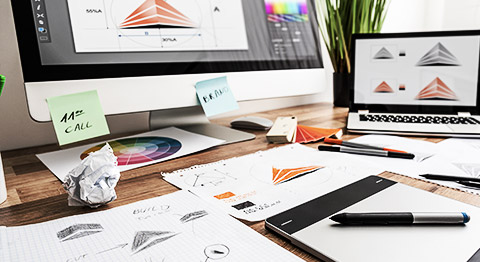
When you are developing drawing and other visual representations, it is necessary to create variety in your compositions.
There are elements and principles of art that you need to be aware of. Explore these in more depth.
| Elements | Definition |
|---|---|
| Line | Has a single dimension, joining two points. It has length and direction. It may be a mark made by a tool, brush, pencil or pen, and can be light, dark or variable |
| Colour | Colour is generated by light reflecting off a surface and describes our experience of this action. Colour, hue, value and intensity are the main characteristics of colour |
| Tone | Tones are black, white and grey and can be described as a range in terms of key or value |
| Texture | Texture is the surface quality from smooth to rough, that can either be felt or observed (literal or implied). Texture can be simulated or actual |
| Shape | The shape is an area contained within an implied line or defined by a change in colour or tone. Shapes have two dimensions: width and breadth. They can be freeform and organic |
| Form | Form describes a three-dimensional area. It can be visual, depicted or physical. It is related to shape, the terminology should be specific |
| Sound | Sound is an audible material in art that can be made electronically or naturally. Sound can also be visual |
| Light | Light is closely aligned to tone and describes the clarity of light rays that illuminate an object or installation |
| Time | Time as a material relates to the physical, emotional or psychological duration of an event or experience in art |
| Principle | Definition |
|---|---|
| Balance | The comparative amounts of colours, tones and textures can create a sense of balance within a composition |
| Contrast | Differences in tone, colours, textures, shapes and other elements used to draw attention or to make dramatic parts of an artwork |
| Emphasis | The artist's application of art elements makes a part or parts of the composition stand out |
| Movement | Pattern, the arrangement of recurring figures/motifs and modules (3D form), can create movement |
| Proportion | Proportion includes the connection between parts and the whole |
| Repetition | A regularly recurring motif/shape/figure creates a pattern. A motif that recurs irregularly is repetition |
| Rhythm | Where the use of an element is repeated. This can be a regular or an irregular repetition and if regular can form a pattern |
| Scale | Refers to the comparative size of shapes or forms, use of time, and volume of sound in an artwork. Examples could be human, small or large scale |
| Space | Terms such as foreground, middle ground, or background are useful terms for discussing space. Techniques include foreshortening, multipoint perspective, or amplified perspective |
| Unity | Refers to the similar or uniform use of an element that unifies or ties together a composition |
| Variety | The diverse use of an element creates a more assorted and visually dynamic composition |
You can create variety in compositions and spatial fields using visual elements – including:
| Example of Variety in Compositions | Description |
|---|---|
|
Shape
|
Use different shapes in your compositions. Make your positive and negative shapes more varied and dynamic. Where appropriate, avoid perfect geometric shapes, straight lines and even edges. Push your shapes so that they do not look uniform. |
|
Size
|
Avoid repetitive, monotonous objects with similar sizes. Rather, depict objects with sizes which vary relative to each other. Size differences may be realistic or not. |
|
Colour
|
Colour can be vivid or muted, warm or cool, straight out of the tube or mixed complicatedly, etc. It is one of the most inspiring and fun ways to add variety to your work, and there are millions of color variations to choose from. You can work in monochrome or use many colors. Change the value (lightness/darkness) or saturation (richness/intensity) of the colours you use. |
|
Contrast
|
Contrast involves using shapes, forms, colour, texture or other elements that are very different from each other. It can create dynamic and eye-catching works. |
|
Difference and change
|
Repeating similar elements but varying one aspect – such as size, colour or position, etc. – can create a unified composition but keep it interesting. |
|
Elaboration
|
Adding detail and complexity to a piece of work can add interest and give the viewer more to look at and think about. |
|
Line variance |
Lines may be thick or thin, broken or continuous, long or short, straight or curved, etc. |
|
Brushwork variance
|
If you are painting, you can make different marks with your brush based on:
|
|
Edge variance
|
If you only use hard edges in your work, then it will look very harsh and rigid. If you only use soft edges in your work, then it will look blurry and out of focus. To create variety, combine the two. |
Overview of experimentation
The previous sections of the unit outlined the variety of different techniques, tools/equipment and materials you may use when developing drawings and other visual representations. It is important to experiment with different techniques, tools/equipment and materials. The purpose is to:
- Identify the correct techniques/tools/materials for the particular piece of work you are undertaking, so you can achieve the objectives of the work and communicate effectively
- Lean how different techniques/tools/materials are applied, for future reference
- Develop your confidence and skills in creating drawings and other visual representations
- Develop new ideas for how you can effectively use drawing in your worn
You should experiment with different techniques, tools/equipment and materials by practicing using these. Find some scrap pieces of paper, or an artists’ or design pad in which you store your ideas, and take time to experiment with a variety of different techniques, tools/equipment and materials. Focus on approaches which are likely to be most relevant to the particular work you are completing, or which you think may apply particularly to the type of work you undertake or your work context.
Single and multi-colour visuals
When you are experimenting with different techniques, tools/equipment and materials, create:
|
Single-colour visuals
|
These use a single colour – though often variations of the colours value (lightness/darkness) or saturation (richness/intensity) – to create an image. |
|
Multi-colour visuals
|
These use two or more colours to create an image. |
As you saw in an earlier section, there are two broad approaches to drawing and visualising:
- Manual approaches – or, developing creative work by hand, using physical tools/ equipment
- Electronic approaches – or, developing creative work using a computer and software
It is important to understand that both electronic and hand drawing techniques are associated with benefits and limitations. This means that both electronic and hand drawing are more (or, therefore, less) useful in different situations and for different purposes. Consider the following examples:
Benefits of electronic and hand drawing
| Electronic Drawing | Hand Drawing |
|---|---|
|
|
Limitations of electronic and hand drawing
| Electronic Drawing | Hand Drawing |
|---|---|
|
|
